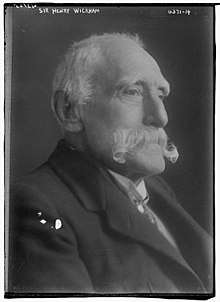Henry Wickham (explorer)
| Sir Henry Wickham | |
|---|---|
 | |
| Born |
Henry Alexander Wickham 29 May 1846 Hampstead, London, England |
| Died |
27 September 1928 (aged 82) Paddington, London, England |
| Occupation | Explorer |
| Spouse(s) | Violet Case Carter |
Sir Henry Alexander Wickham (29 May 1846 – 27 September 1928) was a British explorer and bio-pirate.[1] He later claimed in publicity that he was responsible for stealing about 70,000 seeds[1] from the rubber-bearing tree, Hevea brasiliensis, in the Santarém area of Brazil in 1876. However, there was technically no law at the time forbidding their export although there was a requirement for export licence (which he obtained under false pretense), and from the embellishments added to his original account it would appear that Wickham was trying to make his actions more exciting than they really were.[2] These seeds he accompanied to the Royal Botanic Gardens, Kew, London,[3] from where seedlings were dispatched to British Ceylon (now Sri Lanka), British Malaya (now Peninsular Malaysia) and Singapore, though the latter was not used for rubber), Africa, Batavia in Dutch East Indies (now Jakarta in Indonesia), and other tropical destinations, thus dooming the Amazon rubber boom.
Henry Wickham was born in Hampstead, north London. Wickham's father, a solicitor, died when young Wickham was only four years old.[4][5][6] At age 20 he traveled to Nicaragua, the first of several trips to Latin America and South America.[5] Returning to England, he married Violet Carter in 1871, whose father would publish Wickham's writings.[5] His first book Rough Notes of a Journey Through The Wilderness from Trinidad to Pará, Brazil, by way of the Great Cateracts of the Orinoco, Atabapo, and Rio Negro, was published by W.H.J. Carter in 1872.[5] He would take the entire family to Santarém, Brazil, where his mother, sister Harriette, and the mother-in-law to his brother, John, would all die by 1876.[5] Wickham knighted in the 1920 Birthday Honours "for services in connection with the rubber plantation industry in the Far East."[7]
Rubber plantations in Asia were much more efficient and outproduced Brazil. This was because the Asian rubber plantations were organized and well suited for production on a commercial scale whereas in Brazil the process of latex gathering from forest trees remained a difficult extractive process: rubber tappers worked natural rubber groves in the southern Amazon forest, and rubber tree densities were almost always low, as a consequence of high natural forest diversity. Moreover, experiments in cultivating rubber trees in plantations in the Amazon showed them to be vulnerable to South American rubber tree leaf blight fungus and other diseases and pests.
In spite of decades of research in selecting highly productive and disease resistant rubber trees, many commercial rubber trees throughout the world are descended from the seeds Wickham took to Joseph Dalton Hooker in London.
In Brazil, Wickham is labeled as a "bio-pirate" for his role in smuggling the rubber seeds that broke the Brazilian monopoly. In 1876, no Brazilian law would have prevented Wickham's collection of the seeds, but he may have misrepresented his cargo as dead botanical material destined for the herbarium in order to obtain an export license in Belém.
Notes
- 1 2 Ponting, Clive (2007). A New Green History of the World: The Environment and the Collapse of Great Civilizations. New York: Penguin Books. p. 183. ISBN 978-0-14-303898-6.
- ↑ Musgrave, Toby & Will (2007). An Empire of Plants: People and Plants that Changed the World. London: Cassell & Co. p. 173. ISBN 0-304-35443-0.
- ↑ National Archives: Wickham, Sir Henry Alexander (1846-1928), Knight, explorer and planter – Correspondence relating to the smuggling of rubber seeds from Brazil to Kew, accessed November 2017.
- ↑ Wickham History: Sir Henry Alexander Wickham (1846-1928), accessed November 2017.
- 1 2 3 4 5 Sir Henry Alexander Wickham - at bouncing-balls.com
- ↑ Dean, Warren (1987). Brazil and the Struggle for Rubber: A Study in Environmental History. Cambridge: Cambridge University Press. p.14. ISBN 0-521-33477-2
- ↑ "No. 31931". The London Gazette (Supplement). 4 June 1920. p. 6315.
Bibliography
- Jackson, Joe (2008). The Thief at the End of the World: Rubber, Power, and the Seeds of Empire. Viking.
- Lane, Ann (2008). "Chapter 11 The Pacific as rhizome: the case of Sir Henry Alexander Wickham, planter, and his transnational plants". Transnational Ties: Australian Lives in the World. ANU Press. pp. 183–196. JSTOR j.ctt24hcg1.14.
- Lewis, D. C. (2004). "Wickham, Sir Henry Alexander (1846–1928)". Oxford Dictionary of National Biography.
- Money, Nicholas P. (2006). "Chapter 8: Rubber Eraser". The Triumph of the Fungi: A Rotten History. Oxford University Press. pp. 85–100.
- "Sir Henry Alexander Wickham (1846-1928)" (PDF). Wickham History Society. 2016.
- "PIONEER IN RUBBER IS DEAD IN LONDON: Sir Henry Wickham Made It Possible for World to Ride on Auto Tires". New York Times. 28 Sep 1928.
External links
- Henry Wickham biography - at International Rubber Research & Development Board